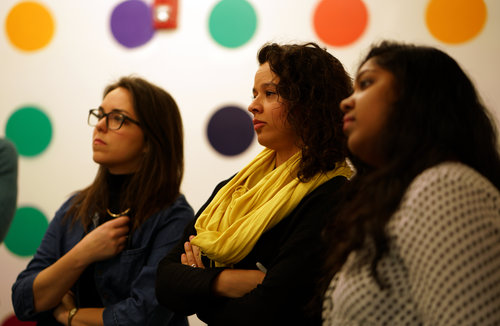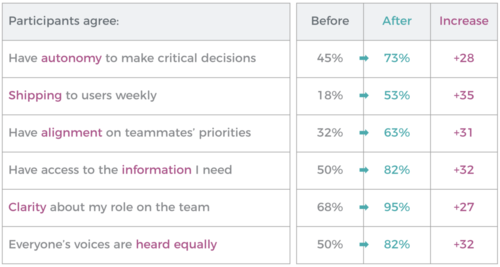Three People Changing 300,000
Our very first case study in seeding and scaling new ways of working and organizing inside a Fortune 500 company.
Background
August has spent two years creating transformational change — at a global scale — inside of one of the world’s largest, oldest and most complex food businesses.
The engagement, epic as it has been, had humble origins. We were brought in after one of the biggest business units in North America had just been restructured. Despite the new org chart, the business simply wasn’t performing.
The Opportunity
Senior executives lamented the ways in which the org was getting in its own way. People spent most of their days in meetings, and the rest of their time either digging themselves out of their inbox or creating endless powerpoint slides for their line managers. Teams were mired in a morass of convoluted decision making, politicking and functional infighting.
Things needed to change.

Our Approach
Phase 1 - Launching the Pilots
We worked with the executive team to identify 5 business critical missions and spun up a team around each. We designed the teams to be lean, autonomous, and multidisciplinary. There was no distinction between makers and managers; everyone on the team rolled up their sleeves to do the work, and embraced their authority to be a decision maker. They were all top-tier talent, and they were trusted implicitly by leaders.
We created conditions which enabled the team to operate differently: with an intense bias for action, and a tolerance for risk manifested through weekly sprints and ships, and relentless testing and learning (both in terms of the ‘product’ they worked on, and the way they worked together).
Not only did each team accomplish their mission, they exceeded all expectations. Perhaps most crucially though, they’d landed on a scalable operating model that enabled teams to operate with unprecedented speed and agility.
Phase 2 - Launching the Movement
Global senior executives were enamoured with the change they’d witnessed — in terms of organisation and team performance, but also in terms of engagement on an individual level.
What followed was a global roll out. First, we codified the key practices that resulted in new behavioral shifts. There were 9 in total. We packaged them up, and then began seeding them in all corners of the business: across categories, functions, geographies, band levels (seniority) and cultures.
We embedded new ways of working and organising as a means to accelerate business critical missions, while simultaneously seeding a grassroots global movement inside of the org in which people ‘opt-in’ to change. To do so, we used our knowledge of spreadable media to effectively leverage existing learning management systems.
These new ways of working and organising started spreading, not only because senior leaders were mandating the change, but because once workers saw the benefits – 15-30x faster project completion, simpler and more effective coordination and cooperation across groups, significant progress against organisational health goals, faster progress toward career and life goals (!) – they spread the methods themselves.
Phase 3 - Designing for Self Sufficiency
Finally, we stood up an internal coalition, designed as an opt-in Center of Excellence, with global and local representation from BUs and functions critical to long-term sustainability. We trained master coaches (again, on an opt-in basis), who are now charged with scaling this new op-model to all four corners of the globe.
We worked with the heads of Transformation and HR to ensure every General Manager understands how to adopt the practices, and we continue to support local markets to get up and running.

“We used to get 1 project done every 18 months, and they weren’t even that innovative. Now we get 6 projects done in 6 months and they’re all amazing.”
— VP, Insights
Outcomes
Through a simple set of practices, we helped accelerate over 40+ business critical missions, sparked a global movement of tens of thousands of people from across the organization, and created measurable behavioral changes that resulted in tangible economic impact (not to mention, making work more engaging for thousands of employees).
We estimate that:
- Over 10,000 people globally so-far have adopted the new practices
- 40+ business critical missions were accelerated by have adopted the new practices
- Teams moved 15-30% faster
- 50 different geographies from around the world have opted-in
- There are 20+ master coaches (globally) who are equipped to help spread the movement
Learnings
What did we learn! So much. Here are a few highlights:
- Don’t force it! Mandatory top-down change invariably fails. Think of the changes you’re making as products — they should meet real needs and get people excited. If you achieve that then people will opt in!
- Start small. Don’t try and fix everything all at once. Make small changes in limited areas and take it from there.
- Engage the stakeholders. Anyone involved in needs to be aware and contribute to the change. This demystifies the change, facilitates buy-in, and brings in tonnes of ideas to improve the engagement.
- Role modeling is crucial. It remains to be one of the most important levers of change. It inspires people, encourages them, and makes it easier to understand what is requested.
- Practice even over preach. Explaining the why is important, but practicing the how is what makes the change eventually happen. If people don’t know how to implement the grandest ideas, they will remain as merely ideas.